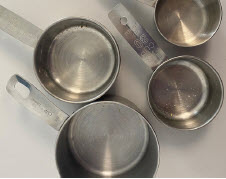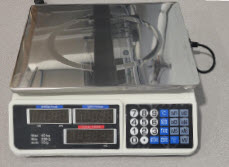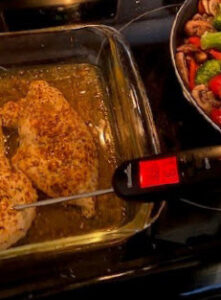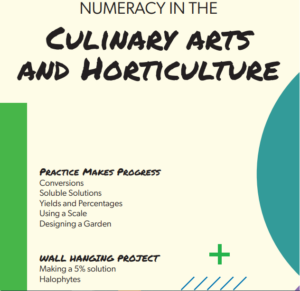Numeracy in Culinary Arts & Horticulture
Measuring Tools
Measuring cups
 Dry measuring cups come in varying sizes such as [latex]\tfrac{1}{4}[/latex] cups, [latex]\tfrac{1}{3}[/latex] cups, [latex]\tfrac{1}{2}[/latex] cups, or [latex]1[/latex] cup. Simply scoop, and level off excess ingredients with a flat object. This in known as the “Dip and Sweep.” Measuring spoons come in smaller portions of [latex]\tfrac{1}{4}[/latex], [latex]\tfrac{1}{2}[/latex] etc in teaspoons and tablespoons. Liquid cannot be measured the same way as dry ingredients, so we measure wet ingredients with a liquid measuring cup. Place on flat surface you can view at eye level for accuracy.
Dry measuring cups come in varying sizes such as [latex]\tfrac{1}{4}[/latex] cups, [latex]\tfrac{1}{3}[/latex] cups, [latex]\tfrac{1}{2}[/latex] cups, or [latex]1[/latex] cup. Simply scoop, and level off excess ingredients with a flat object. This in known as the “Dip and Sweep.” Measuring spoons come in smaller portions of [latex]\tfrac{1}{4}[/latex], [latex]\tfrac{1}{2}[/latex] etc in teaspoons and tablespoons. Liquid cannot be measured the same way as dry ingredients, so we measure wet ingredients with a liquid measuring cup. Place on flat surface you can view at eye level for accuracy.
Scales
 For the most accuracy, while preparing food and measuring ingredients, a scale is your best bet.
For the most accuracy, while preparing food and measuring ingredients, a scale is your best bet.
- Mechanical Scale: place ingredients you wish to weigh on the bowl-like plate, and the hand will move accordingly, pointing to the designated weight reading.
- Digital Scale: provides ultimate accuracy.
- Hanging Scales: come with a hook on the bottom, often used for heavy items like fish and meat.
Thermometers

- Digital Thermometers deliver accurate readings of internal temperatures of food. This is especially crucial for cooking meats, as undercooked meat can sometimes be harmful.
- Instant Read Digital Thermometers have a sensor that will stop when the precise, accurate, current temperature is reached.
- Oven Thermometers stay in the item being cooked while cooking, making it great for consistency. You are able to continuously see the internal temperature as it is being cooked.


